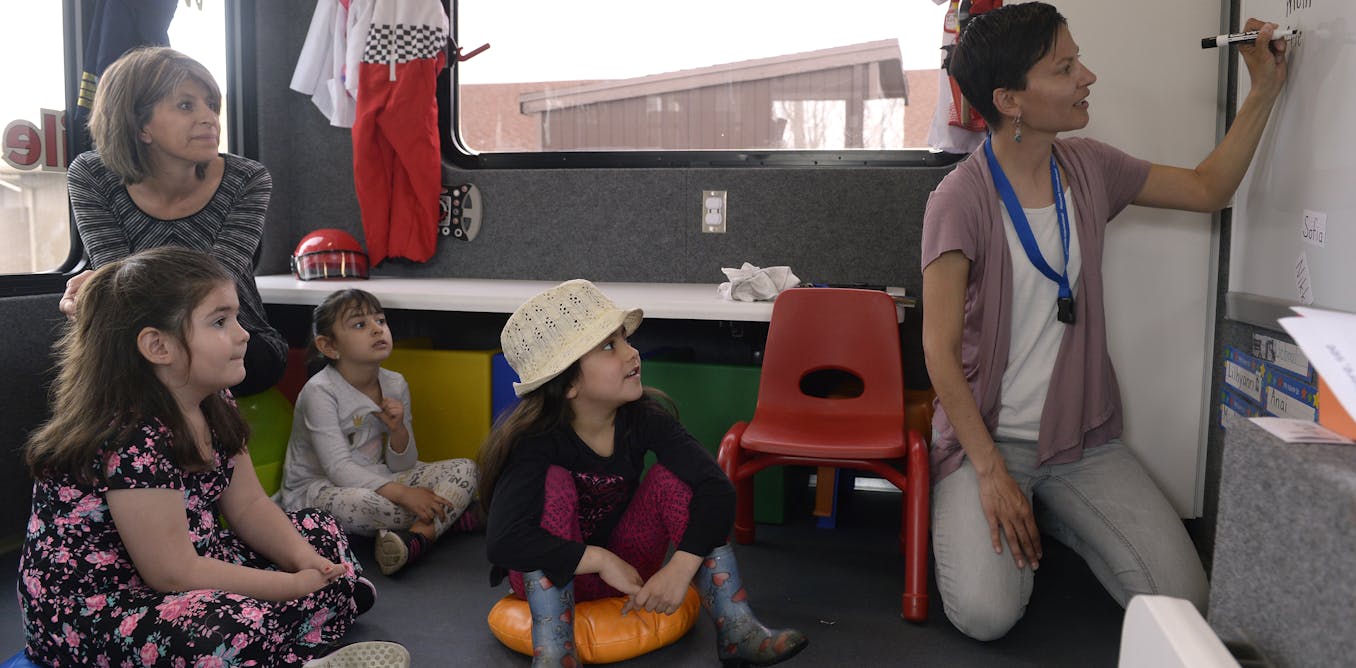Breezing through the 35,000-square-foot home of Materials for the Arts is about as close as you might get to touring Willy Wonka’s chocolate factory. Earlier this year, the vast warehouse in Queens was chock-full of Christmas fixings, like ornaments, pink artificial evergreens, and Lush soap cartons, alongside perennial aisles of paper and books, envelopes, archival photos, all manner of fabric, buttons, beads, and trim. There are also lab coats from hospitals, furniture from the Javits Center, and vintage typewriters and PC towers, CDs and file folders. Full of castoffs of contemporary New York City life just waiting to be plucked from obscurity, the list goes on. The majority of these wares are in pristine condition, and they are all meticulously organized and labeled.
It’s also accessible, for free, to public school students and teachers, as well as art nonprofits.
As New York’s largest creative-reuse center and a program of the city’s Department of Cultural Affairs, Materials for the Arts collects a boundless array of reusable materials from businesses and individuals that are then made available to nonprofits, schools, and other city agencies, thus diverting some 1.7 million pounds of materials from landfills in 2023.
That 1.7 million pounds is almost quadruple the amount of donated material just three years ago, and today the nearly-50-year-old organization is poised to keep expanding as it continues to evolve to meet the needs of the ever-changing, ever-resourceful but ever-resource-strapped city.
“It’s not just about our organization—it’s about our city,” MFTA executive director Tara Sansone told ARTnews. “As New York grows, so too must our program because our mission remains pivotal to the very essence of New York itself.”
In January, buoyed by $50,000 in corporate grants from Southwest Airlines and Sony Corporation of America, MFTA launched an awareness campaign to bolster its ethos and, ultimately, bring more shoppers, as the organization calls them, through its doors, via artist and designer residencies, field-trip and volunteer programs, and a host of educational and public programs that serve more than 6,000 students and 1,000 teachers a year. (It also unveiled a rebrand, courtesy of storied design firm Pentagram, with its new taxicab-yellow identity splashed across Times Square.)
The organization’s future is, in many ways, a long way from its scrappy beginnings. In 1978, Angela Fremont, then an enterprising young artist who was working at the Department of Cultural Affairs, learned that the Central Park Zoo urgently needed a refrigerator to store animal medications. She appealed to a local radio show for help and, following an on-air request, was quickly flooded with responses—which inspired her to apply more broadly the same principle of one’s trash being another’s treasure.

“I became interested in the amount of waste that the city produced,” Fremont told the New York Times in 1981, “and knew it could be used by artists, who often lack the money for materials they need.”
The first donation Fremont received for what would become Materials for the Arts was 50 glass exhibition cases from the Metropolitan Museum of Art, which to this day continues to gift materials to MFTA, like a large cache of recently digitized slides. In the years since, it has granted membership via an application process to local nonprofit groups with at least two years of arts programming, in addition to public schools and government agencies.
While some items are always in stock (paper, chairs, candles, and fashion-industry supplies like zippers, thread, sewing machines, and dress forms), “it’s the unique things that make it really interesting,” Sansone said. “We never know what we’re going to get in.”
Last year, after Broadway’s longest running show closed, MFTA received donations of costumes and set pieces from The Phantom of the Opera. The day we spoke, an anonymous donor had offered up 20 impeccable banquettes custom-made for an event; Sansone was already going through her mental Rolodex of arts organizations who could benefit.

MFTA has seen consistent, rapid growth, Sansone said, in part because of the corporate trend toward sustainability. Luxury brands like Coach have handed over raw materials, like discarded leather, while Kate Spade has donated palettes of handbags and Burberry once gave eight-feet-tall animal sculptures from its West Palm Beach store—some of them found a home at the Staten Island Zoo.
In 2022, as cultural organizations were still recovering, a single donation of 11,000 dance shoes, from tap to ballet footwear, inspired Sansone to launch the Great Dance Shoe Giveaway, where dancers of all ages just had to stop by the warehouse to get a new pair of kicks. “There were teachers in here crying because they said that most of their students had never put a dance shoe on their feet,” she recalled.
Recently, MFTA has expanded its recycling efforts involving the city’s film and TV industry, adding two staff positions concentrating on sourcing these materials. Costumes from The Marvelous Mrs. Maisel, Gossip Girl, and Only Murders in the Building are among the more than a million pounds of materials the agency has received from New York–filmed productions since 2019. A suit worn on Succession recently went to someone who wore it for job interviews.

While serving schools and arts nonprofits has long been its primary focus, Covid marked an inflection point that saw MFTA’s remit expand. During the pandemic, the program began to hear from those beyond its typical membership base: groups making fabric face masks for neighbors, mutual-aid groups, and social justice groups, all in need of supplies.
“We had to redefine art and culture in New York City to be able to support artists and open our doors wider to accommodate New Yorkers in need,” Sansone said. That meant supplying fabric for face masks, donating furniture to hospitals, and resourcing social justice groups galvanized by protests. “Why would we not donate to Queer Black Lives Matter and donate materials for costume making or vinyl for banner making when we had it here in the warehouse,” she added.
MFTA subsequently loosened membership criteria, eliminating the requirement of two years of arts programming and allowing nonprofits to simply show proof of current programming: “A small LGBTQ organization doing park readings in drag to promote literacy—that was one application where I was like, How are we not giving them membership?” Sansone said.

What MFTA collects also benefits New Yorkers who are not using these wares to creative ends, providing clothing and supplies to the city’s Administration for Children’s Services and Homeless Services and supporting recently arrived asylum seekers in coordination with city partners and community groups.
“I know we’re not supposed to be political because we’re city government, but I do feel like there’s activism in what we do,” Sansone said. “I can’t help but feel like that every day because of the impact we make on people’s lives.”
While other similar reuse programs certainly exist, MFTA is unique in its sheer scale of operations with city backing, and other municipalities are also now looking to this example, now in its fifth decade. “If there was a Materials for the Arts in every major city,” Sansone said, “the world would be a much better, greener place, and artists and students would be much happier.”
Of course, Sansone acknowledges, city budgets face cuts from time to time, but she’s secure in the pride that the Department of Cultural Affairs takes in the program: “We make New Yorkers so happy, we offset budgets, and we help people get things that they could not necessarily afford. I don’t think that would ever go away, and if it did, I’d be afraid of the amount of people that would come out to protest at the City Council.”

Since 2012, MFTA has also run an artist residency program, whose alumni include Sui Park, Michael Kelly Williams, and Jean Shin. Sansone said that she hopes to grow the residency program and add more studios and create state-of-the-art education spaces—and a larger warehouse could also be in the offing.
“The more we take in, the more we can give away,” she said.
In a studio off the warehouse, artist Woomin Kim recently created a vibrant series of collaged found fabric panels during her residency, on view there through May 3. “I was shoving fabric into this huge plastic Ikea bag,” Kim recalled about her first visit to MFTA’s warehouse several months ago. “‘This whole warehouse is available for me to create some project?’ It felt like a utopic place.”

The constant churn of change at MFTA reflects the cadence of New York life and has served as a font of artistic inspiration for Kim, she said, recalling being fascinated by a merry-go-round horse that stayed in the warehouse for only a few days.
“New York is filled with objects and people, but here you actually, physically, take a glimpse of it because of the quantity of things coming in and people taking it right away,” Kim said. “People are consuming and throwing away in this city all the time. This organization feels very New York—you feel the energy of the city.”

The post “How a City Agency Saves New York’s Discarded Objects for Art” by Maximilíano Durón was published on 03/29/2024 by www.artnews.com


































